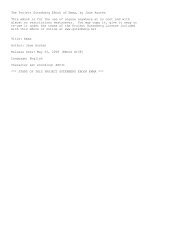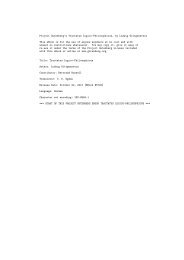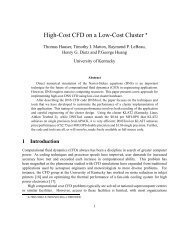PSFs and Bokeh - The Aggregate
PSFs and Bokeh - The Aggregate
PSFs and Bokeh - The Aggregate
You also want an ePaper? Increase the reach of your titles
YUMPU automatically turns print PDFs into web optimized ePapers that Google loves.
<strong>PSFs</strong> <strong>and</strong> <strong>Bokeh</strong><br />
Hank Dietz<br />
Computational Photography, Sept. 28, 2011<br />
University of Kentucky<br />
Electrical & Computer Engineering
Computational Photography<br />
● About using cameras to capture data for<br />
computational processing, rather than making<br />
a pretty image on the sensor...<br />
● Multispectral image processing<br />
● New camera/sensor models<br />
● Intelligent computer control of capture<br />
● Detection/manipulation of image properties
Spring 2009, EE499<br />
● Jennifer Danhauer, Joe Lanford, Ross Levine<br />
● Project to capture a depthmap inside a Canon<br />
PowerShot using depthfromfocus<br />
● CHDK scripting used so single press captures<br />
a sequence with different focus distances<br />
● CHDK processing modified with custom C<br />
code to measure blur & combine images<br />
● Blur measurement was fairly stateoftheart
Measuring Focus Blur<br />
● This is how contrastdetect autofocus works<br />
● Various algorithms in the literature for<br />
determining local contrast between pixels...<br />
Sobel worked best<br />
● Actually done on raw sensor data using just<br />
the green pixel values (they have less noise)<br />
● Limited memory in camera... some cleverness<br />
to avoid keeping N images in memory
How Good Is <strong>The</strong> Depthmap?<br />
● Accurate depths at edges<br />
● No depth in featureless fields<br />
● Wrong depths near edges!<br />
● Wrong by a lot<br />
● Wrong both directions<br />
● Seems to “echo” edges
What Went Wrong?<br />
● What does an outoffocus (OOF) point light<br />
source point spread function (PSF) – look<br />
like?
What Went Wrong?<br />
● Most image processing algorithms treat OOF<br />
point light sources as Gaussian blur:
<strong>The</strong>y Look Like This<br />
● Note the sharp edge!
Point Spread Function<br />
(PSF)<br />
● Describes the response of an imaging<br />
system to a point source (impulse response)<br />
● <strong>The</strong> spatial domain representation of the<br />
Modulation Transfer Function (MTF)<br />
● An image is essentially the sum of the <strong>PSFs</strong><br />
of all points of light in the scene<br />
● PSF size grows in proportion to how OOF
<strong>The</strong> Wrong PSF Model!<br />
● But an OOF point light source imaged by a<br />
real lens (Takumar 135mm f/2.5) looks like:
Each Lens PSF Is Unique<br />
● For a Minolta 50mm f/1.7 with barely visible<br />
fungus it looks like this:
Optical Formula Affects PSF<br />
● For my Sony 1870mm zoom at 18mm f/3.5<br />
the PSF looks like this:
A Simple Retrofocus Lens PSF<br />
● For my Vivitar 28mm f/2.5 it looks like this:
A Classic Mirror Lens PSF<br />
● For my Bower 500mm f/6.3 mirror lens the<br />
PSF looks like this:
PSF with Spherical Aberration<br />
Over<br />
Under<br />
Near Far
Axial Chromatic Aberrations
Cat's Eye / Swirl Vignetting
Symmetric Near & Far<br />
● Before <strong>and</strong> after focus are inverses<br />
(no, they are not ambiguous!)<br />
● Funny things happen around focus<br />
● Different colors in focus at different depths<br />
● Partial “inversion” of pattern
Computational Photography<br />
Using PSF Structures<br />
● After characterizing 100+ real lenses...<br />
● Depthfromfocus/defocus, refocus/allinfocus<br />
● Diagnose lens defects like contamination <strong>and</strong><br />
fabrication flaws (e.g., decentering)<br />
● Forensically identify the type of lens<br />
● Forensically identify the specific lens<br />
● PSF substitution<br />
● Structured apertures & apodization
<strong>Bokeh</strong><br />
● Japanesederived word for the general<br />
properties of OOF regions<br />
● Good bokeh come from Gaussian blur <strong>PSFs</strong><br />
● Nisen bokeh – double line artifacts
Minolta's STF<br />
(Smooth Trans Focus)<br />
● <strong>The</strong> Sony/Minolta 135mm f/2.8 t/4.5 STF<br />
incorporates an apodizing element
Minolta's<br />
Maxixum 7 STF Mode<br />
● Fakes apodization using multiple exposures!<br />
● Here's my version using CHDK:
PSF Substitution<br />
● Commonly attempted for image refocus<br />
● Can improve image <strong>Bokeh</strong> by replacing native<br />
PSF with a Gaussian blur (or other) PSF<br />
● Can directly synthesize “3D” stereo pairs <strong>and</strong><br />
enhance their apparent depth – more on that<br />
next lecture!









